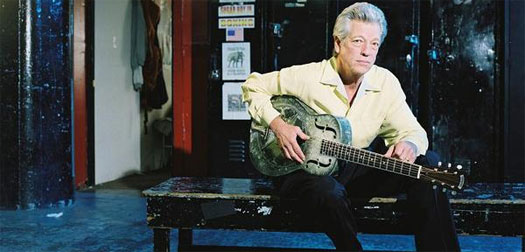Shows
John Hammond
July 26, 2007 at Club Helsinki in Great Barrington‚ MA
by J Hunter
July 27, 2007
John Hammond
July 26, 2007 at Club Helsinki in Great Barrington‚ MA
by J Hunter
July 27, 2007
|
|
|
|
 |
||
|
|
|
If John Hammond doesn't qualify for legend status‚ then nobody does. He's been a performer for nearly 50 years‚ with 31 recordings to his credit‚ including last January's Push Comes to Shove (Back Porch Records)‚ produced by G Love. Hammond played solo acoustic at Club Helsinki‚ a little slice of heaven at the foot of the Berkshires. "It's nice to be back in the club venue‚" he grinned‚ "where the people are right up close." He prefaced his opener "Ride with Me" by saying‚ "I'm just gonna play what I feel like." The response from the crowd was loud and non-verbal‚ but could be easily translated as "Fine by us!"
Hammond wrote five tunes for Push Comes to Shove‚ including "You Know That's Cold‚" a straight blues shuffle that was indistinguishable-in sound and quality-from some of the blues nuggets he served up during a phenomenal 90-minute set. "I'm becoming a songwriter in my old age‚" he chuckled. It's a good line‚ but it's not true. He wrote "Slick Crown Vic" back in 1962‚ when he was playing the L.A. folk scene after being discovered by Hoyt Axton while pumping gas on Wilshire Boulevard. That story sounds like a rejected Hollywood screenplay‚ but it's just one of many things that have happened to Hammond on his incredible journey through the folk and blues scene. It seemed like each song had a story‚ and Hammond was happy to tell them all.
He prefaced "My Time after A While" by telling how he found out it wasn't written by Buddy Guy; he explained how Tampa Red and Big Bill Broonzy formed Chicago's first blues society before he played Tampa's "It Hurts Me Too‚" which may be the first song ever written about co-dependency; he told us how he drove from New York to Los Angeles "in about two-and-a-half days" so he could open for Howling Wolf‚ and how he was stunned to get Wolf as a peer and a confidante. Hammond played two Wolf tunes on this evening‚ including a snarling "How Many More Times" that put Led Zeppelin's thrashing version to shame.
The guitar licks-which Hammond showcased on both a traditional acoustic guitar and a Steel National that was so old the steel was oxidizing-are not as crisp‚ and his voice doesn't have the power it once did. But there's a rasp and a crack at the top of Hammond's range that adds a further air of authenticity (as if he needed it)‚ and his overall vocal style easily evokes John Lee Hooker in his prime. More to the point‚ Hammond's blues harp has a howl that demands both attention and respect while it cuts through everything-glass‚ steel‚ pretense‚ you name it.
suggestions
Albums: Phish - Vegas 96
Features: Video: Favorite Albums of 2009
Shows: Electric Zoo
Features: Grand Point North Festival 2013
Blog: On Deck with Lift Fest - March 16th & 17th
More on: John Hammond
Albums: Phish - Vegas 96
Features: Video: Favorite Albums of 2009
Shows: Electric Zoo
Features: Grand Point North Festival 2013
Blog: On Deck with Lift Fest - March 16th & 17th
More on: John Hammond
new to state of mind
Shows: moe.
Shows: Yonder Mountain String Band
Shows: Grand Point North 2014
Shows: Catskill Chill 2014
Shows: moe.down 15
Shows: Gov't Mule
Shows: Umphrey's McGee
Shows: Newport Folk Festival 2014
Shows: Widespread Panic
Albums: Phish - Fuego
Shows: moe.
Shows: Yonder Mountain String Band
Shows: Grand Point North 2014
Shows: Catskill Chill 2014
Shows: moe.down 15
Shows: Gov't Mule
Shows: Umphrey's McGee
Shows: Newport Folk Festival 2014
Shows: Widespread Panic
Albums: Phish - Fuego
most popular
Blog: New Video/Song From Dr. Dog - "Broken Heart"
Blog: Radiohead: Adam King tries to convince me they are aliens…
Blog: Mountain Oasis welcomes NIN‚ Bassnectar and Pretty Lights
Blog: Mehliana Tour (Brad Mehldau + Mark Guiliana)
Blog: Video: Club d'Elf with Marco Benevento - "Bass Beatbox"
Blog: Reed Mathis and Victor Wooten Talk Bass
Features: Conversation with Kurt Rosenwinkel
Features: Conversation with Tommy Benedetti of John Brown's Body
Features: Conversation with Bill Kreutzmann
Shows: Rothbury 2009
Blog: New Video/Song From Dr. Dog - "Broken Heart"
Blog: Radiohead: Adam King tries to convince me they are aliens…
Blog: Mountain Oasis welcomes NIN‚ Bassnectar and Pretty Lights
Blog: Mehliana Tour (Brad Mehldau + Mark Guiliana)
Blog: Video: Club d'Elf with Marco Benevento - "Bass Beatbox"
Blog: Reed Mathis and Victor Wooten Talk Bass
Features: Conversation with Kurt Rosenwinkel
Features: Conversation with Tommy Benedetti of John Brown's Body
Features: Conversation with Bill Kreutzmann
Shows: Rothbury 2009
